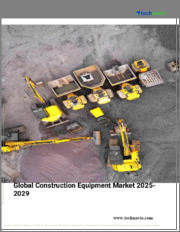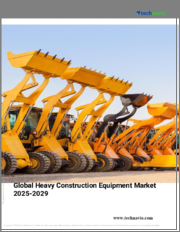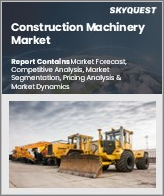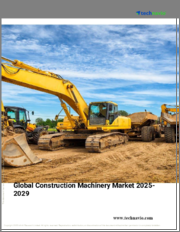
|
시장보고서
상품코드
1573944
세계의 소형 건설기계 시장 : 기계 유형별, 최종 이용 산업별, 용도별, 추진력 유형별, 운전 능력별, 소유자별 - 예측(2025-2030년)Compact Construction Equipment Market by Equipment Type, End-Use Industry, Application, Propulsion Type, Operating Capacity, Ownership - Global Forecast 2025-2030 |
||||||
소형 건설기계 시장의 2023년 시장 규모는 723억 7,000만 달러로 평가되었고, 2024년에는 756억 9,000만 달러로 추정되며, CAGR 5.71%로 성장할 전망이고, 2030년에는 1,068억 2,000만 달러에 달할 것으로 예상됩니다.
소형 건설기계는 다용도 및 이동성이 필요한 건설 작업을 위해 설계된 소형 기계를 의미합니다. 이 카테고리에는 미니 굴삭기, 컴팩트 로더, 스키드 스티어 로더 등이 포함됩니다. 소형 건설기계의 필요성은 대형 기계가 실용적이지 않은 좁은 공간이나 도시 지역에서 효율적으로 작동하는 능력 때문입니다. 이 기계는 주택 및 상업시설 건설, 도로 정비, 농업, 조경 등 다양한 최종 용도 분야에 적용됩니다.
| 주요 시장 통계 | |
|---|---|
| 기준년(2023년) | 723억 7,000만 달러 |
| 예측년(2024년) | 756억 9,000만 달러 |
| 예측년(2030년) | 1,068억 2,000만 달러 |
| CAGR(%) | 5.71% |
소형 건설기계 시장은 도시화의 진전에 의한 좁은 공간에서의 인프라 개척 수요 증가, 기계의 효율성과 안전성을 높이는 텔레매틱스나 스마트 오퍼레이션 등의 기술 진보 등 요인의 영향을 받고 있습니다. 게다가 장비를 구매하는 것보다 렌탈하는 동향은 기업이 렌탈 서비스를 확대할 수 있는 기회를 제공합니다.
그러나 이 시장은 원재료 비용의 변동, 엄격한 배기 가스 규제, 잠재적인 구매자를 망설이는 높은 유지 보수 비용 등의 과제에도 직면하고 있습니다. 최근 세계 사건에서 볼 수 있는 공급망의 혼란은 시장 안정성에 추가적인 위험을 초래합니다. 이러한 과제에도 불구하고 주요 기회는 지속 가능한 엔지니어링 설계와 세계의 녹색 이니셔티브를 따르는 대체 연료원의 통합에 있습니다.
기술 혁신의 가능성이 있는 분야에는 인건비를 삭감하고 운전 작업의 정확도를 높이는 자율 운전 기술과 성능을 높이고 배출량을 삭감하는 배터리 기술의 개량 등이 있습니다. 기업은 이러한 기술에 초점을 맞춘 연구개발에 투자함으로써 경쟁력을 높일 수 있습니다. 시장 역학의 인사이트에 따르면, 동 시장은 역동적이고 탄력적이며, 서비스로서의 장비 모델과 같은 새로운 동향 속에서 전략적으로 자사를 위치시킬 수 있다면, 비즈니스 기회는 제한을 크게 상회합니다. 소형 건설기계 시장의 지속적인 성장과 경쟁력 강화를 위해서는 내재하는 과제와 적응 전략의 균형을 맞추고 기술의 진보를 도입하는 것이 중요합니다.
시장 역학 : 빠르게 진화하는 소형 건설기계 시장의 주요 시장 인사이트 공개
소형 건설기계 시장은 수요 및 공급의 역동적인 상호작용에 의해 변모하고 있습니다. 이러한 시장 역학의 진화를 이해함으로써 기업은 충분한 정보를 바탕으로 투자결정, 전략적 결정 정밀화, 새로운 비즈니스 기회 획득에 대비할 수 있습니다. 이러한 동향을 종합적으로 파악함으로써 기업은 정치적, 지리적, 기술적, 사회적, 경제적 영역에 걸친 다양한 위험을 완화할 수 있으며, 소비자 행동과 그것이 제조 비용과 구매 동향에 미치는 영향을 보다 명확하게 이해할 수 있습니다.
- 시장 성장 촉진요인
- 도시 지역의 공간 제약에 의한 소형 건설 기계 수요 증가
- 자동화되어 기술적으로 진보한 소형 건설기계의 채용 증가
- 세계의 인프라 개발 및 개수 프로젝트에 대한 투자 증가
- 시장 성장 억제요인
- 소형 건설 기계를 취급할 수 있는 숙련 오퍼레이터의 부족
- 소형 건설 기계의 제조 비용에 영향을 미치는 원재료 가격의 변동
- 시장 기회
- 리폼 및 리노베이션 분야에서의 소형 건설 기계 채용 증가
- 소형 건설 기계의 기술 진보에 의한 작업 효율과 안전성의 향상
- 중소기업에 유연한 솔루션을 제공하는 소형 건설기계의 렌탈 서비스 확대
- 시장의 과제
- 소형 건설기계 시장에서 수요 및 공급망 매니지먼트의 과제
- 소형 건설기계 사업에 있어서 품질 및 안전성의 유지
Porter's Five Forces : 소형 건설 기계 시장을 탐색하는 전략 도구
Porter's Five Forces 프레임 워크는 소형 건설기계 시장 경쟁 구도를 이해하는 중요한 도구입니다. Porter's Five Forces 프레임 워크는 기업의 경쟁력을 평가하고 전략적 기회를 탐구하는 명확한 기술을 제공합니다. 이 프레임워크는 기업이 시장 내 세력도를 평가하고 신규 사업의 수익성을 판단하는 데 도움이 됩니다. 이러한 인사이트를 통해 기업은 자사의 강점을 활용하고, 약점을 해결하고, 잠재적인 과제를 피할 수 있으며, 보다 강인한 시장에서의 포지셔닝을 보장할 수 있습니다.
PESTLE 분석 : 소형 건설기계 시장의 외부 영향 파악
외부 거시 환경 요인은 소형 건설기계 시장의 성과 역학을 형성하는 데 매우 중요한 역할을 합니다. 정치적, 경제적, 사회적, 기술적, 법적, 환경적 요인 분석은 이러한 영향을 탐색하는 데 필요한 정보를 제공합니다. PESTLE 요인을 조사함으로써 기업은 잠재적인 위험과 기회를 더 잘 이해할 수 있습니다. 이 분석을 통해 기업은 규제, 소비자 선호, 경제 동향의 변화를 예측하고 앞으로 예상되는 적극적인 의사 결정을 할 준비를 할 수 있습니다.
시장 점유율 분석 : 소형 건설기계 시장 경쟁 구도 파악
소형 건설기계 시장의 상세한 시장 점유율 분석을 통해 공급업체의 성과를 종합적으로 평가할 수 있습니다. 기업은 수익, 고객 기반, 성장률 등 주요 지표를 비교하여 경쟁 포지셔닝을 밝힐 수 있습니다. 이 분석을 통해 시장 집중, 단편화, 통합 동향을 밝혀내고 벤더들은 경쟁이 치열해지는 가운데 자사의 지위를 높이는 전략적 의사 결정을 내리는 데 필요한 지식을 얻을 수 있습니다.
FPNV 포지셔닝 매트릭스 : 소형 건설기계 시장에서 공급업체의 성능 평가
FPNV 포지셔닝 매트릭스는 소형 건설기계 시장에서 공급업체를 평가하는 중요한 도구입니다. 이 행렬을 통해 비즈니스 조직은 공급업체의 비즈니스 전략과 제품 만족도를 기준으로 평가하여 목표에 맞는 충분한 정보를 바탕으로 의사 결정을 내릴 수 있습니다. 네 가지 사분면을 통해 공급업체를 명확하고 정확하게 부문화하고 전략 목표에 가장 적합한 파트너 및 솔루션을 파악할 수 있습니다.
전략 분석 및 추천 : 소형 건설기계 시장에서 성공을 위한 길 그리기
소형 건설기계 시장의 전략 분석은 세계 시장에서의 프레즌스 강화를 목표로 하는 기업에 필수적입니다. 주요 자원, 역량 및 성과 지표를 검토함으로써 기업은 성장 기회를 파악하고 개선을 위해 노력할 수 있습니다. 이러한 접근 방식을 통해 경쟁 구도에서 과제를 극복하고 새로운 비즈니스 기회를 활용하여 장기적인 성공을 거둘 수 있는 체제를 구축할 수 있습니다.
이 보고서는 주요 관심 분야를 포괄하는 시장의 종합적인 분석을 제공합니다.
1. 시장 침투 : 현재 시장 환경의 상세한 검토, 주요 기업의 광범위한 데이터, 시장 도달범위 및 전반적인 영향력 평가.
2. 시장 개척도 : 신흥 시장의 성장 기회를 파악하고 기존 분야의 확장 가능성을 평가하며 미래 성장을 위한 전략적 로드맵을 제공합니다.
3. 시장 다양화 : 최근 제품 출시, 미개척 지역, 업계의 주요 진보, 시장을 형성하는 전략적 투자를 분석합니다.
4. 경쟁 평가 및 정보 : 경쟁 구도를 철저히 분석하여 시장 점유율, 사업 전략, 제품 포트폴리오, 인증, 규제 당국 승인, 특허 동향, 주요 기업의 기술 진보 등을 검증합니다.
5. 제품 개발 및 혁신 : 미래 시장 성장을 가속할 것으로 예상되는 최첨단 기술, 연구개발 활동, 제품 혁신을 강조합니다.
또한 이해관계자가 충분한 정보를 얻고 의사결정을 할 수 있도록 중요한 질문에 대답하고 있습니다.
1. 현재 시장 규모 및 향후 성장 예측은?
2. 최고의 투자 기회를 제공하는 제품, 부문 및 지역은 어디입니까?
3. 시장을 형성하는 주요 기술 동향 및 규제의 영향은?
4. 주요 벤더의 시장 점유율 및 경쟁 포지션은?
5. 벤더 시장 진입 및 철수 전략의 원동력이 되는 수익원과 전략적 기회는 무엇인가?
목차
제1장 서문
제2장 조사 방법
제3장 주요 요약
제4장 시장 개요
제5장 시장 인사이트
- 시장 역학
- 성장 촉진요인
- 도시의 스페이스 제약에 의해 소형 건설 기계 수요 증가
- 자동화 및 기술 진보 채용 증가 소형 건설 기계
- 세계적으로 인프라 개발 및 개수 프로젝트에 대한 투자 증가
- 억제요인
- 소형 건설 기계의 취급에 숙련된 오퍼레이터 부족
- 원재료 가격의 변동이 소형 건설 기계의 제조 비용에 영향
- 기회
- 리폼 및 리노베이션 분야에서의 소형 건설 기계의 채용 증가
- 운용 효율과 안전성을 높이는 소형 건설 기계의 기술적 진보
- 중소기업에 유연한 솔루션을 제공하는 소형 건설기계의 렌탈 서비스 확대
- 과제
- 수요 및 공급망 관리 문제 소형 건설 기계 시장
- 소형 건설기계 업무에 있어서 품질 및 안전성의 유지
- 성장 촉진요인
- 시장 세분화 분석
- Porter's Five Forces 분석
- PESTEL 분석
- 정치적
- 경제
- 사교
- 기술적
- 법률상
- 환경
제6장 소형 건설기계 시장 : 기기 유형별
- 컴팩트 트랙 로더
- 소형 휠 로더
- 미니 굴삭기
- 스키드 스티어 로더
제7장 소형 건설기계 시장 : 최종 이용 산업별
- 농업
- 농작물 재배
- 축산
- 공사
- 상업건설
- 산업건설
- 주택건설
- 조경
- 광업
제8장 소형 건설기계 시장 : 용도별
- 해체
- 발굴
- 리프팅 및 감기
- 자재관리
제9장 소형 건설기계 시장 : 추진 유형별
- 디젤
- 전기
- 하이브리드
제10장 소형 건설기계 시장 : 가동 능력별
- 2000-3000 파운드
- 3000 파운드 이상
- 2000 파운드 미만
제11장 소형 건설기계 시장 : 소유권별
- 소유
- 렌탈
제12장 아메리카의 소형 건설기계 시장
- 아르헨티나
- 브라질
- 캐나다
- 멕시코
- 미국
제13장 아시아태평양의 소형 건설기계 시장
- 호주
- 중국
- 인도
- 인도네시아
- 일본
- 말레이시아
- 필리핀
- 싱가포르
- 한국
- 대만
- 태국
- 베트남
제14장 유럽, 중동 및 아프리카의 소형 건설기계 시장
- 덴마크
- 이집트
- 핀란드
- 프랑스
- 독일
- 이스라엘
- 이탈리아
- 네덜란드
- 나이지리아
- 노르웨이
- 폴란드
- 카타르
- 러시아
- 사우디아라비아
- 남아프리카
- 스페인
- 스웨덴
- 스위스
- 터키
- 아랍에미리트(UAE)
- 영국
제15장 경쟁 구도
- 시장 점유율 분석(2023년)
- FPNV 포지셔닝 매트릭스(2023년)
- 경쟁 시나리오 분석
- 전략 분석 및 제안
The Compact Construction Equipment Market was valued at USD 72.37 billion in 2023, expected to reach USD 75.69 billion in 2024, and is projected to grow at a CAGR of 5.71%, to USD 106.82 billion by 2030.
Compact construction equipment refers to small-scale machinery designed for construction tasks requiring versatility and mobility. This category includes mini excavators, compact loaders, and skid steer loaders, among others. The necessity for compact construction equipment stems from its ability to operate efficiently in tight spaces and urban areas where larger machines are impractical. These machines are applied across various end-use sectors including residential and commercial construction, road maintenance, agriculture, and landscaping.
| KEY MARKET STATISTICS | |
|---|---|
| Base Year [2023] | USD 72.37 billion |
| Estimated Year [2024] | USD 75.69 billion |
| Forecast Year [2030] | USD 106.82 billion |
| CAGR (%) | 5.71% |
The market for compact construction equipment is influenced by factors such as increasing urbanization, which drives demand for infrastructure development in confined spaces, and technological advancements, including telematics and smart operations, which enhance machine efficiency and safety. Additionally, the trend toward renting rather than purchasing equipment presents opportunities for companies to expand rental services.
However, the market also faces challenges such as fluctuations in raw material costs, stringent emission norms, and high maintenance costs which can deter potential buyers. Supply chain disruptions, as evidenced by recent global events, pose additional risks to market stability. Despite these challenges, key opportunities lie in sustainable engineering designs and the integration of alternative fuel sources to align with global green initiatives.
Potential areas of innovation include autonomous operation technologies, which can reduce labor costs and increase precision in operational tasks, and improved battery technologies to boost performance and decrease emissions. Companies can gain a competitive edge by investing in research and development focused on these technologies. Insight into the compact construction equipment market reveals it as both dynamic and resilient, with opportunities significantly outweighing the limitations if companies strategically position themselves within emerging trends such as equipment-as-a-service models. Balancing the inherent challenges with adaptive strategies and embracing technological advancements will be crucial for sustained growth and competitive performance in the compact construction equipment market.
Market Dynamics: Unveiling Key Market Insights in the Rapidly Evolving Compact Construction Equipment Market
The Compact Construction Equipment Market is undergoing transformative changes driven by a dynamic interplay of supply and demand factors. Understanding these evolving market dynamics prepares business organizations to make informed investment decisions, refine strategic decisions, and seize new opportunities. By gaining a comprehensive view of these trends, business organizations can mitigate various risks across political, geographic, technical, social, and economic domains while also gaining a clearer understanding of consumer behavior and its impact on manufacturing costs and purchasing trends.
- Market Drivers
- Increasing demand for compact construction equipment due to space constraints in urban areas
- Growing adoption of automated and technologically advanced compact construction equipment
- Rising investments in infrastructure development and renovation projects globally
- Market Restraints
- Limited availability of skilled operators proficient in handling compact construction equipment
- Volatility in raw material prices impacting the manufacturing costs of compact construction equipment
- Market Opportunities
- Rising adoption of compact construction equipment in the renovation and remodeling sectors
- Technological advancements in compact construction equipment enhancing operational efficiency and safety
- Expansion of rental services for compact construction equipment offering flexible solutions for small businesses
- Market Challenges
- Demand and supply chain management issues in compact construction equipment market
- Maintaining quality and safety in compact construction equipment operations
Porter's Five Forces: A Strategic Tool for Navigating the Compact Construction Equipment Market
Porter's five forces framework is a critical tool for understanding the competitive landscape of the Compact Construction Equipment Market. It offers business organizations with a clear methodology for evaluating their competitive positioning and exploring strategic opportunities. This framework helps businesses assess the power dynamics within the market and determine the profitability of new ventures. With these insights, business organizations can leverage their strengths, address weaknesses, and avoid potential challenges, ensuring a more resilient market positioning.
PESTLE Analysis: Navigating External Influences in the Compact Construction Equipment Market
External macro-environmental factors play a pivotal role in shaping the performance dynamics of the Compact Construction Equipment Market. Political, Economic, Social, Technological, Legal, and Environmental factors analysis provides the necessary information to navigate these influences. By examining PESTLE factors, businesses can better understand potential risks and opportunities. This analysis enables business organizations to anticipate changes in regulations, consumer preferences, and economic trends, ensuring they are prepared to make proactive, forward-thinking decisions.
Market Share Analysis: Understanding the Competitive Landscape in the Compact Construction Equipment Market
A detailed market share analysis in the Compact Construction Equipment Market provides a comprehensive assessment of vendors' performance. Companies can identify their competitive positioning by comparing key metrics, including revenue, customer base, and growth rates. This analysis highlights market concentration, fragmentation, and trends in consolidation, offering vendors the insights required to make strategic decisions that enhance their position in an increasingly competitive landscape.
FPNV Positioning Matrix: Evaluating Vendors' Performance in the Compact Construction Equipment Market
The Forefront, Pathfinder, Niche, Vital (FPNV) Positioning Matrix is a critical tool for evaluating vendors within the Compact Construction Equipment Market. This matrix enables business organizations to make well-informed decisions that align with their goals by assessing vendors based on their business strategy and product satisfaction. The four quadrants provide a clear and precise segmentation of vendors, helping users identify the right partners and solutions that best fit their strategic objectives.
Strategy Analysis & Recommendation: Charting a Path to Success in the Compact Construction Equipment Market
A strategic analysis of the Compact Construction Equipment Market is essential for businesses looking to strengthen their global market presence. By reviewing key resources, capabilities, and performance indicators, business organizations can identify growth opportunities and work toward improvement. This approach helps businesses navigate challenges in the competitive landscape and ensures they are well-positioned to capitalize on newer opportunities and drive long-term success.
Key Company Profiles
The report delves into recent significant developments in the Compact Construction Equipment Market, highlighting leading vendors and their innovative profiles. These include Bobcat Company, CASE Construction Equipment, Caterpillar Inc., Doosan Infracore, Hitachi Construction Machinery Co., Ltd., Hyundai Construction Equipment Co., Ltd., JCB (J.C. Bamford Excavators Limited), John Deere, Komatsu Ltd., Kubota Corporation, Liebherr Group, New Holland Construction, Sany Heavy Industry Co., Ltd., Sumitomo Construction Machinery Co., Ltd., Takeuchi Mfg. Co., Ltd., Terex Corporation, Volvo Construction Equipment, Wacker Neuson SE, Yanmar Holdings Co., Ltd., and Zoomlion Heavy Industry Science and Technology Co., Ltd..
Market Segmentation & Coverage
This research report categorizes the Compact Construction Equipment Market to forecast the revenues and analyze trends in each of the following sub-markets:
- Based on Equipment Type, market is studied across Compact Track Loaders, Compact Wheel Loaders, Mini Excavators, and Skid Steer Loaders.
- Based on End-Use Industry, market is studied across Agriculture, Construction, Landscaping, and Mining. The Agriculture is further studied across Crop Farming and Livestock Farming. The Construction is further studied across Commercial Construction, Industrial Construction, and Residential Construction.
- Based on Application, market is studied across Demolition, Excavation, Lifting And Hoisting, and Material Handling.
- Based on Propulsion Type, market is studied across Diesel, Electric, and Hybrid.
- Based on Operating Capacity, market is studied across 2000 - 3000 lbs, Above 3000 lbs, and Less Than 2000 lbs.
- Based on Ownership, market is studied across Owned and Rented.
- Based on Region, market is studied across Americas, Asia-Pacific, and Europe, Middle East & Africa. The Americas is further studied across Argentina, Brazil, Canada, Mexico, and United States. The United States is further studied across California, Florida, Illinois, New York, Ohio, Pennsylvania, and Texas. The Asia-Pacific is further studied across Australia, China, India, Indonesia, Japan, Malaysia, Philippines, Singapore, South Korea, Taiwan, Thailand, and Vietnam. The Europe, Middle East & Africa is further studied across Denmark, Egypt, Finland, France, Germany, Israel, Italy, Netherlands, Nigeria, Norway, Poland, Qatar, Russia, Saudi Arabia, South Africa, Spain, Sweden, Switzerland, Turkey, United Arab Emirates, and United Kingdom.
The report offers a comprehensive analysis of the market, covering key focus areas:
1. Market Penetration: A detailed review of the current market environment, including extensive data from top industry players, evaluating their market reach and overall influence.
2. Market Development: Identifies growth opportunities in emerging markets and assesses expansion potential in established sectors, providing a strategic roadmap for future growth.
3. Market Diversification: Analyzes recent product launches, untapped geographic regions, major industry advancements, and strategic investments reshaping the market.
4. Competitive Assessment & Intelligence: Provides a thorough analysis of the competitive landscape, examining market share, business strategies, product portfolios, certifications, regulatory approvals, patent trends, and technological advancements of key players.
5. Product Development & Innovation: Highlights cutting-edge technologies, R&D activities, and product innovations expected to drive future market growth.
The report also answers critical questions to aid stakeholders in making informed decisions:
1. What is the current market size, and what is the forecasted growth?
2. Which products, segments, and regions offer the best investment opportunities?
3. What are the key technology trends and regulatory influences shaping the market?
4. How do leading vendors rank in terms of market share and competitive positioning?
5. What revenue sources and strategic opportunities drive vendors' market entry or exit strategies?
Table of Contents
1. Preface
- 1.1. Objectives of the Study
- 1.2. Market Segmentation & Coverage
- 1.3. Years Considered for the Study
- 1.4. Currency & Pricing
- 1.5. Language
- 1.6. Stakeholders
2. Research Methodology
- 2.1. Define: Research Objective
- 2.2. Determine: Research Design
- 2.3. Prepare: Research Instrument
- 2.4. Collect: Data Source
- 2.5. Analyze: Data Interpretation
- 2.6. Formulate: Data Verification
- 2.7. Publish: Research Report
- 2.8. Repeat: Report Update
3. Executive Summary
4. Market Overview
5. Market Insights
- 5.1. Market Dynamics
- 5.1.1. Drivers
- 5.1.1.1. Increasing demand for compact construction equipment due to space constraints in urban areas
- 5.1.1.2. Growing adoption of automated and technologically advanced compact construction equipment
- 5.1.1.3. Rising investments in infrastructure development and renovation projects globally
- 5.1.2. Restraints
- 5.1.2.1. Limited availability of skilled operators proficient in handling compact construction equipment
- 5.1.2.2. Volatility in raw material prices impacting the manufacturing costs of compact construction equipment
- 5.1.3. Opportunities
- 5.1.3.1. Rising adoption of compact construction equipment in the renovation and remodeling sectors
- 5.1.3.2. Technological advancements in compact construction equipment enhancing operational efficiency and safety
- 5.1.3.3. Expansion of rental services for compact construction equipment offering flexible solutions for small businesses
- 5.1.4. Challenges
- 5.1.4.1. Demand and supply chain management issues in compact construction equipment market
- 5.1.4.2. Maintaining quality and safety in compact construction equipment operations
- 5.1.1. Drivers
- 5.2. Market Segmentation Analysis
- 5.3. Porter's Five Forces Analysis
- 5.3.1. Threat of New Entrants
- 5.3.2. Threat of Substitutes
- 5.3.3. Bargaining Power of Customers
- 5.3.4. Bargaining Power of Suppliers
- 5.3.5. Industry Rivalry
- 5.4. PESTLE Analysis
- 5.4.1. Political
- 5.4.2. Economic
- 5.4.3. Social
- 5.4.4. Technological
- 5.4.5. Legal
- 5.4.6. Environmental
6. Compact Construction Equipment Market, by Equipment Type
- 6.1. Introduction
- 6.2. Compact Track Loaders
- 6.3. Compact Wheel Loaders
- 6.4. Mini Excavators
- 6.5. Skid Steer Loaders
7. Compact Construction Equipment Market, by End-Use Industry
- 7.1. Introduction
- 7.2. Agriculture
- 7.2.1. Crop Farming
- 7.2.2. Livestock Farming
- 7.3. Construction
- 7.3.1. Commercial Construction
- 7.3.2. Industrial Construction
- 7.3.3. Residential Construction
- 7.4. Landscaping
- 7.5. Mining
8. Compact Construction Equipment Market, by Application
- 8.1. Introduction
- 8.2. Demolition
- 8.3. Excavation
- 8.4. Lifting And Hoisting
- 8.5. Material Handling
9. Compact Construction Equipment Market, by Propulsion Type
- 9.1. Introduction
- 9.2. Diesel
- 9.3. Electric
- 9.4. Hybrid
10. Compact Construction Equipment Market, by Operating Capacity
- 10.1. Introduction
- 10.2. 2000 - 3000 lbs
- 10.3. Above 3000 lbs
- 10.4. Less Than 2000 lbs
11. Compact Construction Equipment Market, by Ownership
- 11.1. Introduction
- 11.2. Owned
- 11.3. Rented
12. Americas Compact Construction Equipment Market
- 12.1. Introduction
- 12.2. Argentina
- 12.3. Brazil
- 12.4. Canada
- 12.5. Mexico
- 12.6. United States
13. Asia-Pacific Compact Construction Equipment Market
- 13.1. Introduction
- 13.2. Australia
- 13.3. China
- 13.4. India
- 13.5. Indonesia
- 13.6. Japan
- 13.7. Malaysia
- 13.8. Philippines
- 13.9. Singapore
- 13.10. South Korea
- 13.11. Taiwan
- 13.12. Thailand
- 13.13. Vietnam
14. Europe, Middle East & Africa Compact Construction Equipment Market
- 14.1. Introduction
- 14.2. Denmark
- 14.3. Egypt
- 14.4. Finland
- 14.5. France
- 14.6. Germany
- 14.7. Israel
- 14.8. Italy
- 14.9. Netherlands
- 14.10. Nigeria
- 14.11. Norway
- 14.12. Poland
- 14.13. Qatar
- 14.14. Russia
- 14.15. Saudi Arabia
- 14.16. South Africa
- 14.17. Spain
- 14.18. Sweden
- 14.19. Switzerland
- 14.20. Turkey
- 14.21. United Arab Emirates
- 14.22. United Kingdom
15. Competitive Landscape
- 15.1. Market Share Analysis, 2023
- 15.2. FPNV Positioning Matrix, 2023
- 15.3. Competitive Scenario Analysis
- 15.4. Strategy Analysis & Recommendation
Companies Mentioned
- 1. Bobcat Company
- 2. CASE Construction Equipment
- 3. Caterpillar Inc.
- 4. Doosan Infracore
- 5. Hitachi Construction Machinery Co., Ltd.
- 6. Hyundai Construction Equipment Co., Ltd.
- 7. JCB (J.C. Bamford Excavators Limited)
- 8. John Deere
- 9. Komatsu Ltd.
- 10. Kubota Corporation
- 11. Liebherr Group
- 12. New Holland Construction
- 13. Sany Heavy Industry Co., Ltd.
- 14. Sumitomo Construction Machinery Co., Ltd.
- 15. Takeuchi Mfg. Co., Ltd.
- 16. Terex Corporation
- 17. Volvo Construction Equipment
- 18. Wacker Neuson SE
- 19. Yanmar Holdings Co., Ltd.
- 20. Zoomlion Heavy Industry Science and Technology Co., Ltd.



















